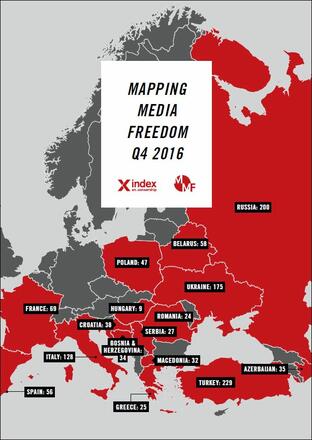
Mapping media freedom 2016
(Originally published by mappingmediafreedom.org )
During 2016, nine journalists were killed; 205 were assaulted; 347 were detained or arrested; there were 178 reports of criminal charges and lawsuits; 390 reports of intimidation, which includes psychological abuse, sexual harassment, trolling/cyberbullying and defamation; media professionals were subject to attacks to their property 143 times; journalists or sources were blocked 299 times; and journalists’ work was altered or censored 102 times.
“The precarious state of press freedom across the globe is underlined by the volume of verified incidents added to Mapping Media Freedom in 2016. The spectrum of threats is growing, the pressure on journalists increasing and the public right to transparent information is under assault. People who are simply trying to do their job are being targeted like never before. These trends do not bode well for 2017,” Hannah Machlin, Mapping Media Freedom project officer, said.
Some of the major themes in the data – and which journalists should be wary of in 2017 – include:
- Violence from right-wing groups
- Dangers faced when reporting on protests and demonstrations organised across the political spectrum
- Impunity: Physical attacks on journalists not properly investigated; government officials intimidating reporters without fear of punishment
- Difficulties reporting on refugees, including denied access and violence
- Silencing journalists by arresting them on ties to terrorist or extremist groups
- Libel laws subjecting media outlets and reporters to high fines and imprisonment
- Economic difficulties leading to the closure or restructuring of media outlets and buyouts by wealthy businesspeople, often leading to job cuts and dismissals
- State of emergency laws being used to detain journalists without charge
- Death threats and smear campaigns disseminated online
The content of this article can be used according to the terms of Creative Commons: Attribution-NonCommercial 4.0 International (CC BY-NC 4.0) . To do so use the the wording "this article was originally published on the Resource Centre on Media Freedom in Europe" including a direct active link to the original article page.

